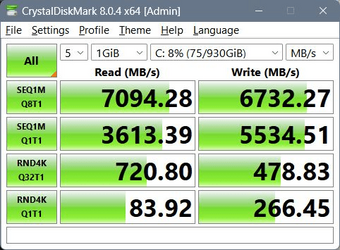It all started with a Sk hynix Platinum P41, same size as my previous 980 Pro boot drive. A Macrium clone of the 980 to the P41 resulted in "Inaccessible Boot device".
I then wiped the drive and did a Macrium restore. No joy, same result. Macrium "Fix Boot Problem" didn't work, neither did any bcdboot commands.
So I gave it a try with Hasleo, same exact result. Two backup suites, same "Inaccessible Boot device". I figured it must be this drive.
I found a 1TB 990 Pro an Amazon for $79.99 US so I bought it. When I installed it I restored an older 23H2 image and guess what? "Inaccessible Boot device". The only thing I could do with this new drive (as well as the P41) was clean install Windows, so I did. I had it running really well except for intermittent issues with both my Lan and WiFi, even with the latest drivers installed. "Oops, were having trouble finding that page". Selecting Retry would load the page. It was random, with any website.
I really really wanted my previous install back, so I gave it another try with the 990 Pro, no joy. So I turned on my System 2 and started searching. I ran across this thread on the Macrium Forum about this same issue. Member jphughan suggested using Macrium's ReDeploy tool. I figured, what the heck, I'll give it a whirl.
Well, lo and behold, it worked! Booted right up. I've made multiple Macrium clones in the past without any issues until these two drives. My old 980 Pro boot drive wasa clone of my previous boot drive and it booted fine. So when all else fails, try ReDeploy, it worked for me.
Cheers,
Scott

I then wiped the drive and did a Macrium restore. No joy, same result. Macrium "Fix Boot Problem" didn't work, neither did any bcdboot commands.
So I gave it a try with Hasleo, same exact result. Two backup suites, same "Inaccessible Boot device". I figured it must be this drive.
I found a 1TB 990 Pro an Amazon for $79.99 US so I bought it. When I installed it I restored an older 23H2 image and guess what? "Inaccessible Boot device". The only thing I could do with this new drive (as well as the P41) was clean install Windows, so I did. I had it running really well except for intermittent issues with both my Lan and WiFi, even with the latest drivers installed. "Oops, were having trouble finding that page". Selecting Retry would load the page. It was random, with any website.
I really really wanted my previous install back, so I gave it another try with the 990 Pro, no joy. So I turned on my System 2 and started searching. I ran across this thread on the Macrium Forum about this same issue. Member jphughan suggested using Macrium's ReDeploy tool. I figured, what the heck, I'll give it a whirl.
Well, lo and behold, it worked! Booted right up. I've made multiple Macrium clones in the past without any issues until these two drives. My old 980 Pro boot drive wasa clone of my previous boot drive and it booted fine. So when all else fails, try ReDeploy, it worked for me.
Cheers,
Scott

My Computers
System One System Two
-
- OS
- Win 11 Pro 24H2 26100.4484
- Computer type
- PC/Desktop
- Manufacturer/Model
- Self Built
- CPU
- Intel® Core™ i7-14700F
- Motherboard
- ASUS TUF Z690-PLUS WIFI BIOS v4101
- Memory
- G.SKILL Ripjaws S5 Series 64GB (2 x 32GB) DDR5
- Graphics Card(s)
- MSI GeForce RTX 3060 Ventus 2X 12GB OC
- Sound Card
- Sound Blaster AE-5 Plus
- Monitor(s) Displays
- ASUS TUF Gaming 27" 2K HDR Gaming
- Screen Resolution
- 2560 x 1440
- Hard Drives
- Samsung 990 Pro 1TB NVMe (Win 11 24H2)
SK hynix P41 500GB NVMe (24H2 VHDX)
SK hynix P41 2TB NVMe (x3)
Crucial P3 Plus 4TB
- PSU
- Corsair RM850x Shift
- Case
- Antec Dark Phantom DP502 FLUX
- Cooling
- Noctua NH-U12A chromax.black + 7 Phantek T-30's
- Keyboard
- Logitech MK 320
- Mouse
- Razer Basilisk V3
- Internet Speed
- 350Mbs
- Browser
- Firefox
- Antivirus
- Winows Security
- Other Info
- ASUS BW-16D1HT OD
Windows 11 25H2 26200.5670 (VHDX)
On System One (Dual Boot)
-
- Operating System
- Win 11 Pro 24H2 26100.4484
- Computer type
- PC/Desktop
- Manufacturer/Model
- Self Built
- CPU
- Intel Core i7-11700F
- Motherboard
- Asus TUF Gaming Z590 Plus WiFi
- Memory
- 64 GB DDR4
- Graphics card(s)
- EVGA GeForce RTX 2060
- Sound Card
- SoundBlaster Audigy Fx V2
- Monitor(s) Displays
- Samsung F27T350
- Screen Resolution
- 1920x1080
- Hard Drives
- Samsung 980 Pro 1TB
Samsung 970 EVO Plus 2TB
Samsung 870 EVO 500GB SSD
- PSU
- Corsair HX750
- Case
- Cougar MX330-G Window
- Cooling
- Hyper 212 EVO
- Internet Speed
- 350Mbps
- Browser
- Firefox
- Antivirus
- Windows Security






